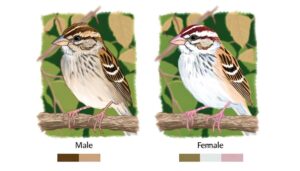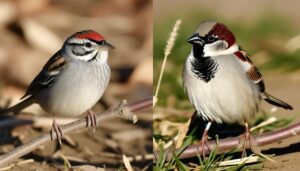7 Common Types of Sparrows You Should Know
Common types of sparrows include the widely seen House Sparrow with its robust body and grey-brown plumage. American Tree Sparrows, larger with a bicolored bill, and Eurasian Tree Sparrows, possessing a chestnut crown and nape, are other notable species.
The Chipping Sparrow stands out with a high-pitched trill and slender build. The Song Sparrow, notable for unique melodies, communicates and defends its territory through song.
Fox Sparrows showcase adaptability with a broad geographic distribution, square tail, and stout beak. The diversity in characteristics and behaviors of sparrows is immense, making for a fascinating journey into their world.

Key Takeaways
- House Sparrows are recognized by their robust body, round head, short beak, and grey-brown plumage.
- American Tree Sparrows are larger, with a bicolored bill and a preference for ground nesting.
- Eurasian Tree Sparrows are smaller and have unique markings, including a chestnut crown and nape with black patches.
- Chipping Sparrows are slender with a rusty cap, grey face, and are known for their high-pitched trill.
- Fox Sparrows, identifiable by their squared tail and rufous plumage, demonstrate adaptability with a geographic distribution spanning from northern Canada to US coastal areas.
House Sparrow Characteristics
What distinguishes the House Sparrow from other species?
Its distinct physical traits, which include a robust body, a round head, short, stubby beak, and a wingspan typically measuring around 20-22 cm, set it apart in the avian world.
In addition, the House Sparrow's plumage is mainly grey and brown, displaying sexual dimorphism with males being more brightly colored than females.
Behaviorally, they're known for their adaptability, thriving in both rural and urban environments.
Dietarily, they're omnivorous, feeding on seeds, fruits, and small invertebrates.
Moreover, their vocalizations, often described as incessant chirping, are unique to their species.
These attributes contribute to the House Sparrow's widespread distribution and significant presence in human-altered landscapes.
Understanding the American Tree Sparrow
Moving from the urban-adapted House Sparrow, we now turn our attention to the American Tree Sparrow, a bird that thrives in the chilly habitats of North America's tundra and boreal forests.
A contrast to its urban counterpart, this sparrow prefers remote, freezing regions. Often mistaken for its close relative, the Chipping Sparrow, the American Tree Sparrow can be distinguished by its bicolored bill, with a dark upper mandible and a yellow lower one.
It's a hardy species, feeding on a diet rich in seeds, berries, and insects. Concerning size, it's slightly larger than the House Sparrow, averaging around 6.3 inches in length.
Intriguingly, despite its name, it doesn't nest in trees but opts for ground nesting instead.
Spotlight on the Eurasian Tree Sparrow
The Eurasian Tree Sparrow (Passer montanus) is the focus of the next section, and its identification features, habitat, and behavior will be examined. This species, widely distributed across Europe and Asia, exhibits distinct characteristics that distinguish it from other sparrows.
Its preferred habitats and behavioral patterns, which are influenced by its geographical location and environmental factors, will be detailed.
Identifying Eurasian Tree Sparrow
Distinguished by its rich, chestnut crown and nape, along with a black patch on each pure white cheek, the Eurasian Tree Sparrow (Passer montanus) isn't your typical sparrow. This bird carries a unique bilateral symmetry in its markings, a characteristic that aids in identification.
It's noticeably smaller than the common House Sparrow, measuring around 12.5 to 14 cm in length with a wingspan of 21 cm. Males and females sport similar plumage, making gender identification a challenge.
Its beak, a stout, conical shape, is black in the breeding season and horn-colored at other times. The bird's upper parts are a warm, sandy brown while the underparts are lighter, often described as dirty white. Observing these features will help guarantee accurate identification.
Habitat and Behavior
Having identified its distinctive features, we can now explore the habitat and behavior of the Eurasian Tree Sparrow, shedding light on its unique living conditions and activities.
- Habitat: Eurasian Tree Sparrows mainly inhabit open farmland and human settlements in Europe and parts of Asia. They've adapted to urban areas, often nesting in buildings.
- Diet: They primarily eat seeds, supplemented by insects during the breeding season.
- Breeding Behavior: Unlike the solitary House Sparrow, they often breed in loose colonies. They construct messy nests in trees or buildings.
- Social Behavior: Eurasian Tree Sparrows are sociable birds, forming large flocks outside the breeding season. Interaction within these flocks is marked by a complex social structure.
Understanding these aspects provides a detailed view of their lifestyle, necessary for effective conservation strategies.
Song Sparrow and Its Melodies
The Song Sparrow, scientifically known as Melospiza melodia, is renowned for its unique and intricate chirps.
These melodious sounds, which vary greatly among individual sparrows, aren't only soothing to human ears but also serve essential functions in the bird's communication and territorial defense.
A thorough understanding of these sparrow melodies can offer valuable insights into the species' behavior, social structure, and adaptation strategies.
Song Sparrow's Unique Chirps
In the world of sparrows, one can't help but notice the unique melodies produced by the Song Sparrow, marked by a complex sequence of chirps and trills. These songs aren't random, but are carefully crafted, each note carrying specific meanings.
Here's a glimpse into the Song Sparrow's signature chirps:
- Pitch: The Song Sparrow's chirps vary in pitch, adding depth to its melodies. Higher pitches are typically used to signal alarms or threats.
- Frequency: The frequency of these chirps often indicates the bird's emotional state. Rapid, repeated chirps usually signify excitement.
- Volume: The volume can determine the distance of communication. Louder chirps are often used for long-distance calls.
- Duration: Longer chirps might be used during mating calls, while shorter ones can be used for simple communication.
Understanding these elements will help in deciphering the Song Sparrow's unique language of chirps and trills.
Understanding Sparrow Melodies
While one might find it challenging to comprehend the intricate sparrow melodies, it's worth noting that each Song Sparrow's tune carries distinct messages, conveyed through variations in pitch, frequency, volume, and duration. These differences in melodies aren't arbitrary; they're vital for communication among sparrows.
High-frequency chirps, for instance, may signify alert, while a more mellow tune could indicate courtship. Timing also matters as sparrows use different songs at dawn, midday, and dusk. Their ability to produce a wide range of frequencies and volumes is due to their highly developed syrinx, a vocal organ unique to birds.
Chipping Sparrow Identification Guide
Among the numerous species of sparrows, you'll find the Chipping Sparrow, easily identified by its striking features. This bird, scientifically known as Spizella passerina, is a small sparrow native to North America.
- Size and Shape: The Chipping Sparrow is a slender bird with a long, notched tail and a fairly small bill. It measures about 4.7-5.9 inches in length.
- Color Pattern: It's recognized by its bright, rusty cap, a clear gray face, and a crisp, black, thin line through the eye.
- Habitat: These sparrows generally prefer open woodlands, gardens, parks, and suburban areas for their habitat.
- Vocalization: Their song is a simple, repetitive, high-pitched trill, often described as a rapid 'chip-chip-chip-chip'.
Understanding these features should aid in the successful identification of the Chipping Sparrow.
Savannah Sparrow: A Closer Look
The Savannah Sparrow, scientifically known as Passerculus sandwichensis, is another fascinating species worth examining for its unique characteristics and behaviors. This sparrow species is lauded for its adaptability, surviving in a wide range of habitats – from salt marshes to prairies. It possesses a distinct, streaked plumage, making it easily identifiable.
| Characteristics | Description |
|---|---|
| Size | 4.3-5.9 in (11-15 cm) |
| Weight | 0.5-1 oz (15-28 g) |
| Lifespan | Up to 6 years |
The Savannah Sparrow's diet consists mainly of insects during summer and seeds in the winter, showcasing its versatility. Its song, a series of high-pitched notes followed by a trill, is a delightful sound in its habitats. Its scientific name, sandwichensis, is a tribute to Sandwich Bay, where it was first discovered.
The Distinctive White-throated Sparrow
Moving on to another intriguing species, we find the White-throated Sparrow, known scientifically as Zonotrichia albicollis, which stands out due to its vividly colored plumage and melodious song. This bird boasts a distinctive white throat, a feature that earned it its common name, complemented by yellow lores and streaks of black and white on its crown.
Here are four interesting aspects to deepen your understanding of this species:
- Size and Distribution: They're medium-sized sparrows, found mainly in North America, especially in Canada during breeding season.
- Habitat: They prefer the cover of dense undergrowth in forests or shrubby, wet areas.
- Diet: They primarily feed on seeds, fruits and insects.
- Behavior: Known for their distinctive song, they're often heard before they're seen.
Stay tuned for more sparrow facts in the next section.
Fox Sparrow Facts and Figures
The Fox Sparrow, known for its distinctive traits, exhibits a wide geographic distribution. Its range extends across varied habitats, each with its own subspecies, exhibiting unique adaptations to their environment.
An examination of the Fox Sparrow's diet and behavior reveals a bird well-suited to its surroundings, with feeding habits that reflect its specific habitat and lifestyle.
Fox Sparrow Identification Traits
Sporting a heavy-set beak and a chunky body, the Fox Sparrow's distinctive markings and behaviors make it an intriguing species to observe. The Fox Sparrow is a master of camouflage with its speckled brown and grey feathers. It's a hearty bird, larger than its sparrow counterparts, measuring up to 7 inches in length.
To identify a Fox Sparrow, look out for these traits:
- Squared Tail: Unlike other sparrows, the Fox Sparrow has a noticeably square tail, which it flicks frequently.
- Large Beak: It features a stout, triangular beak, ideal for crushing seeds.
- Thick Streaks: It has heavy, thick streaks on its chest and flanks.
- Rufous Coloring: The Fox Sparrow's plumage varies, but it often has a rufous or reddish hue, hence the name.
These traits make the Fox Sparrow a fascinating avian spectacle.
Fox Sparrow's Geographic Distribution
With a range extending across North America, Fox Sparrows boast a diverse geographic distribution. Uniquely, they can be found in distinct regions during different seasons. In summer, they inhabit the boreal forests and tundra of northern Canada and Alaska. Winter migration takes them to the eastern and western coasts of the United States. Fox Sparrows have also been sighted as far south as Central America, demonstrating their adaptability to varying habitats.
| Season | Region | Habitat |
|---|---|---|
| Summer | Northern Canada and Alaska | Boreal forests and tundra |
| Winter | Eastern and Western United States | Varied, coastal areas |
| Occasional sightings | Central America | Diverse |
Their extensive distribution makes Fox Sparrows an exciting subject for birdwatchers across North America.
Fox Sparrow's Diet and Behavior
Fox Sparrows, known for their adaptability, primarily feed on insects, seeds, and berries while exhibiting a robust, scratch-and-peck foraging behavior. This scratching is often so powerful, it can kick back leaves to reveal hidden food sources.
To understand their behavior and diet better, consider these four key points:
- Fox Sparrows use their strong legs to kick away leaf litter and expose insects or seeds hidden underneath.
- Their diet varies seasonally. In summer, they feast on insects and spiders, while during winter, they switch to seeds and berries.
- Fox Sparrows are solitary and territorial birds, often observed alone or in small groups.
- They're active during the day and retire to dense shrubs or low branches at night to rest.
These behaviors have allowed Fox Sparrows to thrive across diverse habitats.
The Unique Lincoln's Sparrow
Among the diverse plethora of sparrows, the Lincoln's Sparrow stands out due to its distinct plumage and unique song. It's a medium-sized sparrow with striking features: a buffy facial color and a fine, dark streaking across the chest and back.
This streaking pattern is more intricate compared to other sparrows, giving it a distinct appearance. The Lincoln's Sparrow also has a unique song, characterized by melodious trills and rich notes, making it easily identifiable.
The bird's habitat is typically in dense, wet areas like marshes, bogs, and wet meadows. It's a secretive sparrow, often staying low in vegetation, making it a challenge for birdwatchers to spot.
The Lincoln's Sparrow, with its unique features and behavior, truly sets itself apart in the world of sparrows.
Golden-crowned Sparrow: Key Features
The Golden-crowned Sparrow is a striking bird, easily recognized by its golden-yellow crown and grayish body, providing it a distinctive presence in the sparrow family. It hails from the western region of North America, a migratory bird adapting to different climates with grace.
This sparrow's scientific name, Zonotrichia atricapilla, reflects its defining feature: a golden crown, 'aurea corona' in Latin.
- Size: Typically 15-17 cm long, with a wingspan reaching up to 25 cm.
- Diet: Omnivorous, primarily consuming seeds, berries, insects, and caterpillars.
- Habitat: Prefers open, scrubby areas, from sea level up to the alpine zone.
- Voice: Song consists of three clear, descending notes, often described as a melancholic phrase.
The Golden-crowned Sparrow leaves an indelible mark in avian taxonomy, a tribute to nature's splendor.
Unveiling the Vesper Sparrow
Moving on to another member of the sparrow family, we're now set to explore the Vesper Sparrow, a bird scientifically classified as Pooecetes gramineus, noted for its distinctive evening song that inspired its common name.
This bird, native to North America, is recognized by its streaked brown upperparts, white underparts with thin streaks, and a chestnut shoulder patch. Its song is a series of melodious whistles, often performed at dusk – hence the name 'Vesper'.
The Vesper Sparrow's habitat ranges from grasslands to open woodlands, where it nests on ground level, concealed by vegetation. Its diet mainly consists of seeds and insects.
The Mysterious Dark-eyed Junco
While the Vesper Sparrow enchants with its evening serenade, our attention shifts to the Dark-eyed Junco, a sparrow renowned for its elusive nature. Often found in North America, this bird is renowned for its striking appearance and distinctive behaviors.
To appreciate the Dark-eyed Junco's uniqueness, consider the following:
- *Plumage*: Unlike many sparrows, Dark-eyed Juncos sport a two-toned plumage—dusky above, snowy below—a contrast that's both startling and attractive.
- *Migration*: They're one of the few sparrows that migrate, often traveling in large groups from northern breeding grounds to southern winter habitats.
- *Feeding*: Unlike ground feeders, these birds prefer foraging among the foliage, displaying agility and precision.
- *Breeding*: Their nesting habits are fascinating; they often choose concealed locations, adding to their mysterious appeal.
Grasshopper Sparrow: An Unusual Species
Distinguished by its peculiar song that resembles the sound of a grasshopper, the Grasshopper Sparrow is an unusual species worth delving into. Scientifically named Ammodramus savannarum, this sparrow species is found across North America, particularly in grasslands and open fields.
It's a small bird, typically about five inches in length, with a brown, streaked back and a plain, buffy breast. The wings are short and rounded, aiding in their skulking behavior among tall grass. This species is primarily insectivorous, which is reflected in its song: a high, thin, insect-like buzz that's often difficult to pinpoint.
The Grasshopper Sparrow's unique characteristics, from its unusual song to its habitat preference, make it a fascinating bird for both casual observers and avid birdwatchers.
Conclusion
In the vast tapestry of nature, sparrows hold their own unique threads. Unassuming yet remarkable, these creatures flit from the familiar House Sparrow to the melodious Song Sparrow, the enigmatic Dark-eyed Junco to the peculiar Grasshopper Sparrow.
Their presence, though often overlooked, is a tribute to nature's enduring diversity. So, next time you spot a sparrow, pause and appreciate its subtle beauty. For in the grand symphony of life, each sparrow sings its own distinctive song.






